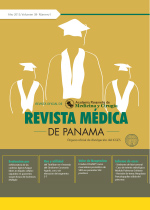Estudio descriptivo de las características epidemiológicas, patológicas y de tratamiento en pacientes tratados por Sarcoma en el Instituto Oncológico Nacional de Panamá desde 2004 al 2011.
Autores/as
DOI:
https://doi.org/10.37980/im.journal.rmdp.2014160Resumen
Dado que en Panamá no existen datos para caracterizar el comportamiento clínico y epidemiológico de los pacientes con diagnóstico de Sarcoma, se plantea este estudio para conocer al respecto. Se presenta una serie de 105 casos de sarcoma que tenían edad promedio de 49,5 años. El síntoma mes frecuente fue la presencia de masa, cuyo diámetro promedio fue de 12.4 cms., mayormente localizado en compartimentos profundos. La estirpe histológica fue el liposarcoma. La mayor parte de los pacientes recibieron el tratamiento estándar de cirugía y radioterapia. 12.4% de los pacientes tuvieron recurrencia local y 16.1 % recurrencia a distancia. La localización más frecuente fue en miembros inferiores.
A descriptive study of the epidemiological, pathological and treatment in patients treated for sarcoma at the National Cancer Institute of Panama from 2004 to 2011.
Summary
Given that in Panama there are no data to characterize the clinical and epidemiological profile of patients diagnosed with sarcoma, this study raises to know about it. A series of 105 cases of sarcoma that had average age of 49.5 years is presented. The month frequent symptom was the presence of mass, whose average diameter was 12.4 cm., Mostly located in deep compartments. The histologic diagnosis was liposarcoma. Most of the patients received the standard treatment of surgery and radiotherapy. 12.4% of patients had local recurrence and distant recurrence 16.1%. The most common location was the lower limbs.
Key Word: sarcoma, neoplasia, histological subtypes.
Publicado
Número
Sección
Licencia
Derechos autoriales y de reproducibilidad. La Revista Médica de Panama es un ente académico, sin fines de lucro, que forma parte de la Academia Panameña de Medicina y Cirugía. Sus publicaciones son de tipo acceso gratuito de su contenido para uso individual y académico, sin restricción. Los derechos autoriales de cada artículo son retenidos por sus autores. Al Publicar en la Revista, el autor otorga Licencia permanente, exclusiva, e irrevocable a la Sociedad para la edición del manuscrito, y otorga a la empresa editorial, Infomedic International Licencia de uso de distribución, indexación y comercial exclusiva, permanente e irrevocable de su contenido y para la generación de productos y servicios derivados del mismo. En caso que el autor obtenga la licencia CC BY, el artículo y sus derivados son de libre acceso y distribución.






